The Return of the Portégé: Dynabook Launches 2019 Portégé X30
by Anton Shilov on July 12, 2019 1:00 PM EST- Posted in
- Notebooks
- Toshiba
- Laptops
- Portege
- Portege X30
- Whiskey Lake
- Dynabook
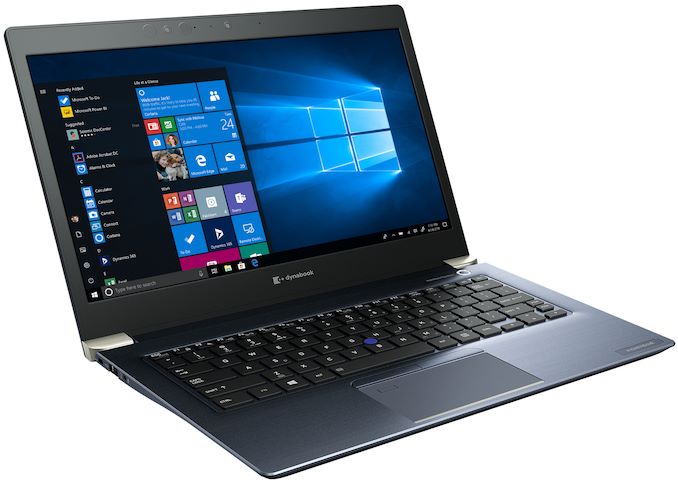
Because of the corporate turmoil in 2016 – 2018 and uncertain future of its PC business, Toshiba has not updated its popular Portégé family of notebooks in the US for more than two years. After Foxconn/Sharp gained control of the said business unit and renamed it to Dynabook, they started to launch new laptops. Among the first new mobile PCs to be released in the USA are the 2019 Portégé X30 notebooks with Intel’s Whiskey Lake CPUs.
Traditionally, Portégé X30 machines have been aimed at demanding business, enterprise, and government users seeking both portability as well as rich feature sets. The new Portégé X30 is not an exception: the system comes in a familiar Onyx Blue magnesium allow chassis that enables it to bring together high performance, connectivity, security, and a weight that is among the lowest in the 13.3-inch class. Just like its direct predecessor from 2017, Dynabook’s new Portégé X30 weighs 1.05 kilograms (2.31 lbs) and is 15.9 mm thick.
When it comes to internals, the new Portégé X30 packs Intel’s 8th Gen Core i3/i5/i7 processor with built-in UHD Graphics 620 that is accompanied by 8, 16 GB or 32 GB of DDR4 memory as well as up to 1 TB SSD (SATA or PCIe). The CPU is now cooled down using a new quieter S-Type fan and a new cooling system that enables better airflow.
As far as connectivity is concerned, the new laptops are equipped with a Wi-Fi 5 + Bluetooth 5 wireless module, an optional 4G/LTE (select models only) modem, two Thunderbolt 3 ports that can work in DisplayPort and USB 3.1 Gen 2 modes, one USB Type-A connector, one HDMI output, a microSD card reader, and a 3.5-mm audio jack. Traditionally for Toshiba X-series notebooks, the Portégé X30 comes with a backlit, spill-resistant keyboard with a trackpoint nub that complements the touchpad. As for multimedia capabilities, the PC has a stereo sub-system comprising speakers co-designed with Harman Kardon that also carry a DTS badge.
Being aimed at customers who value security and reliability, the Portégé X30 comes equipped with SecurePad with Synaptics Natural ID fingerprint sensor, a webcam with IR sensors (for Windows Hello facial recognition) as well as a Trusted Platform Module (TPM 2.0).
| Dynabook's Portege X30 | ||
| General Specifications | ||
| Display | 13.3" 1920×1080 13.3" 1920×1080 with 10-point multitouch |
|
| CPU | Core i3-8145U Core i5-8265U Core i5-8365U Core i7-8565U Core i7-8665U |
|
| Graphics | HD Graphics 620 (24 EUs) | |
| RAM | 8/16/32 GB DDR4 | |
| Storage | Up to 1 TB SSD (SATA or PCIe) | |
| Wi-Fi | Wi-Fi 5 (802.11ac) | |
| Bluetooth | Bluetooth 5 | |
| USB 3.0 | 1 × Type-A | |
| TB3 | 2 × Type-C TB3/USB 3.1 ports (also used for charging, external display, etc.) | |
| Card Reader | MicroSD | |
| Fingerprint Sensor | Yes | |
| Other I/O | Webcam with RGB + IR sensors, microphone, stereo speakers, audio jack | |
| Battery | 48 Wh (?) | |
| Thickness | 15.9 mm (0.62 inches) | |
| Weight | Starting at 1.05 kg (2.31 lbs) | |
| Price | ? | |
Dynabook’s Portégé X30 come with an international three-year warranty, which will certainly please frequent travelers. Dynabook Americas will start sales of the new laptops in August (in time for BTS season) at prices that will depend on exact configurations.
Related Reading:
- Toshiba's PC Products Rebranded to Dynabook
- Dynabook Shows Off New G-Series Laptops: Under 2 Pound Ultrabook With 19 Hour Battery Life
- Toshiba Announces Portégé X30: 13.3” FHD, Core i7, 16 GB DDR4, Thunderbolt 3
- Foxconn Takes Control of Sharp
Source: Dynabook Americas



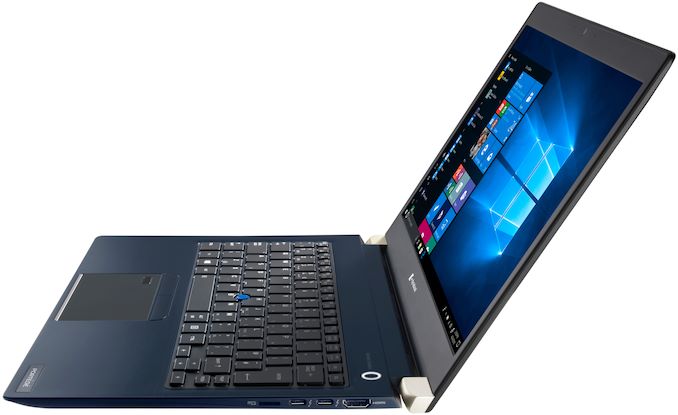
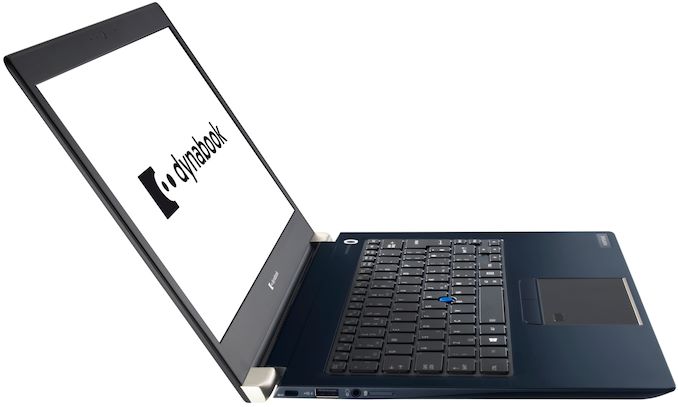
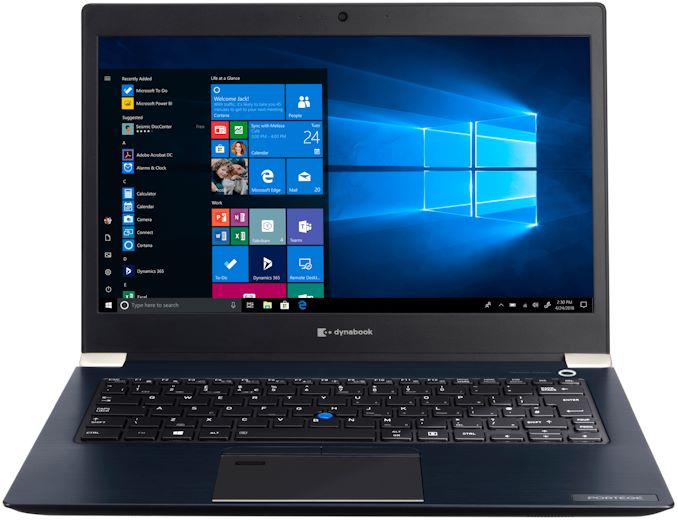
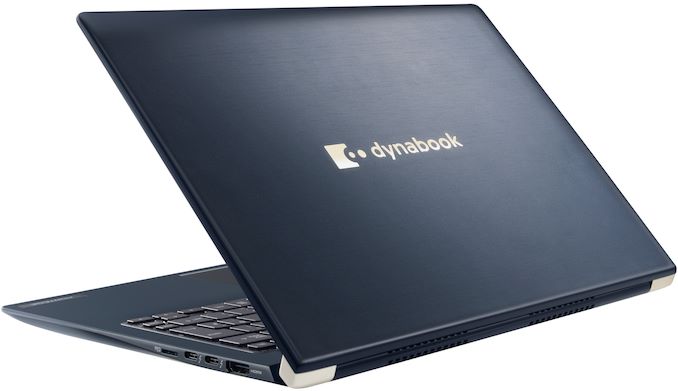








20 Comments
View All Comments
PeachNCream - Friday, July 12, 2019 - link
What is an s-type cooling fan?eastcoast_pete - Friday, July 12, 2019 - link
I had the same question. @Anton: I know you're basically stuck reproducing the press release from Dynabook, but that would be a good question to ask their marketing geniuses. Also, whoever wrote their press release didn't do Dynabook any favors; anybody with even a little tech background smells the marketing BS emanating from such terms as "s-type cooling fan", and that's not what one wants when trying to get potential customers interested.thomasg - Friday, July 12, 2019 - link
S-type fans are fans with strongly curved blades, so the fan blades opposite each other form a "S" shape.The term appears to be used pretty much exclusively in china (as well as the fan design which has become increasingly less common).
This likely doesn't come from the marketing department, but straight out of a translation of the Chinese spec sheets, since this has clearly been developed in China (or Taiwan), not in Japan (as Toshiba stuff used to be).
Samus - Saturday, July 13, 2019 - link
It's worth pointing out the reason S blades are uncommon, ESPECIALLY in laptops, is because their performance deteriorates incredibly fast as they build up with dust, which they are naturally more prone to collecting because of the variable angled surface area.Most fans collect dust on the edge. Well, S blades have a 'longer' edge.
johnnypoulet - Friday, July 12, 2019 - link
I wonder if Toshiba knows that the word in French is Protégé, Portégé is simply not a word. Haha!goatfajitas - Friday, July 12, 2019 - link
It was named back when they had the Libretto (super small) Portege (medium) and Tecra (large) laptop lines so yeah, I am guessing they know ;)MamiyaOtaru - Friday, July 12, 2019 - link
Protege is a word in English too, thanks to our predilection for borrowing anything and everything from any language we please :)ZPrime - Friday, July 12, 2019 - link
I'm pretty sure "Portégé " is a purposefully made-up marketing word. They wanted to evoke Protégé, but they wanted to stress how portable it is... hence Portégé.eastcoast_pete - Friday, July 12, 2019 - link
I believe it was named (made up) after portage, which means carrying, to carry. Porteges were, from the get-go, positioned as easy-to-carry laptops. I had one of the really early ones, chunky by today's standard, but much lighter than it's competition.Guspaz - Saturday, July 13, 2019 - link
I owned a Portégé. Super light because of the magnesium alloy chassis. Also super fragile because of the magnesium alloy chassis. It was put down a bit roughly on a tile floor, while inside of a neoprene padded case, while inside of a laptop backpack. The whole corner of the thing shattered as if it were made of glass, like, into little pieces, because apparently magnesium alloy is super brittle. Toshiba refused to repair it even *out* of warranty ("we don't have the parts") and forced me to use a third-party repair shop in another country (because the Toshiba salesperson lied to me about support for US products in Canada) that charged me half the price of the laptop just to replace the broken chassis (no damage to ANY electronics, it was just the metal shell) and they failed to correctly re-assembly the keyboard (which was glued on) so every time I typed on the keyboard it made the sound of, like, crackling cellophane.So, even if this isn't Toshiba anymore, it's the same business unit, and they're using at least some of the same design cues, so buyer beware.